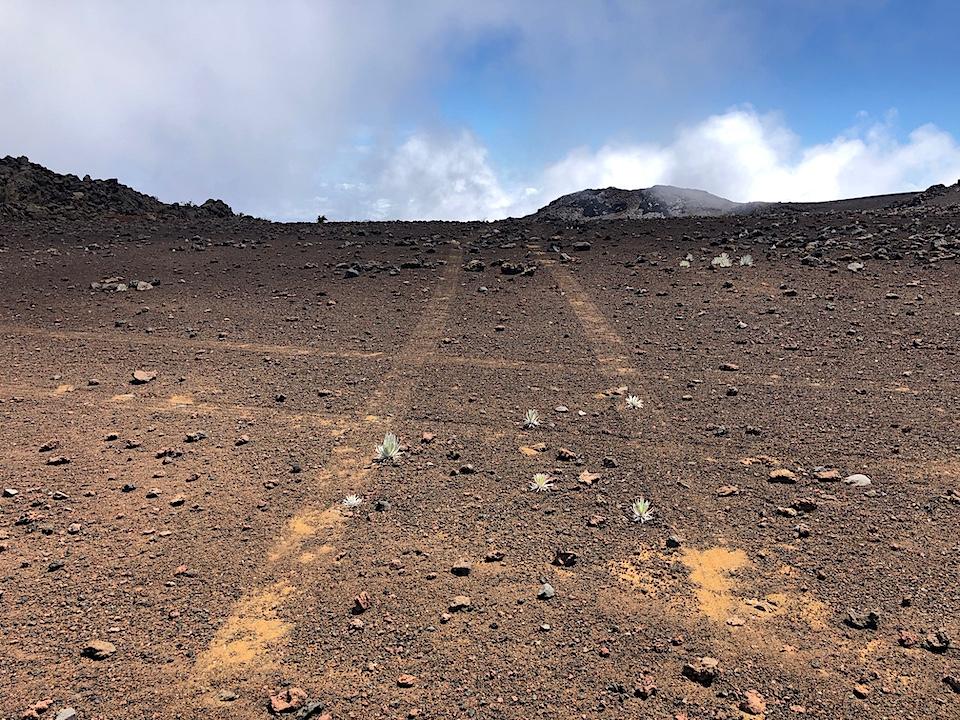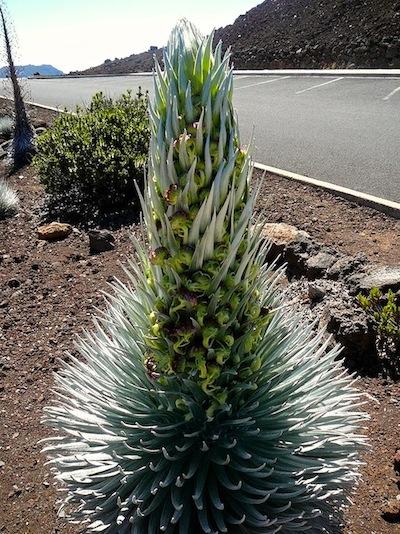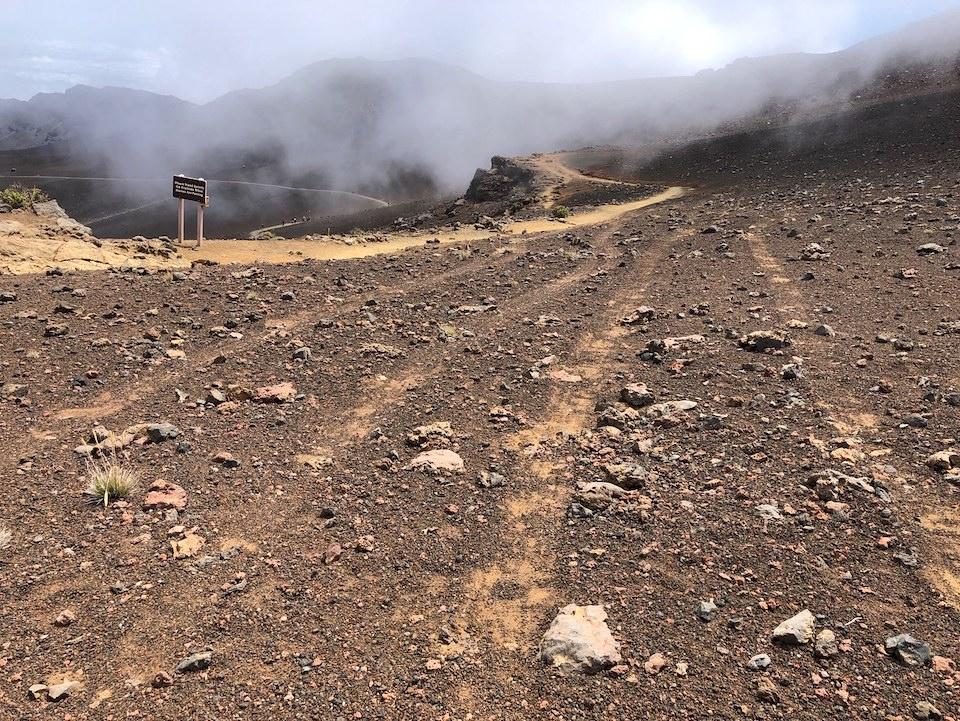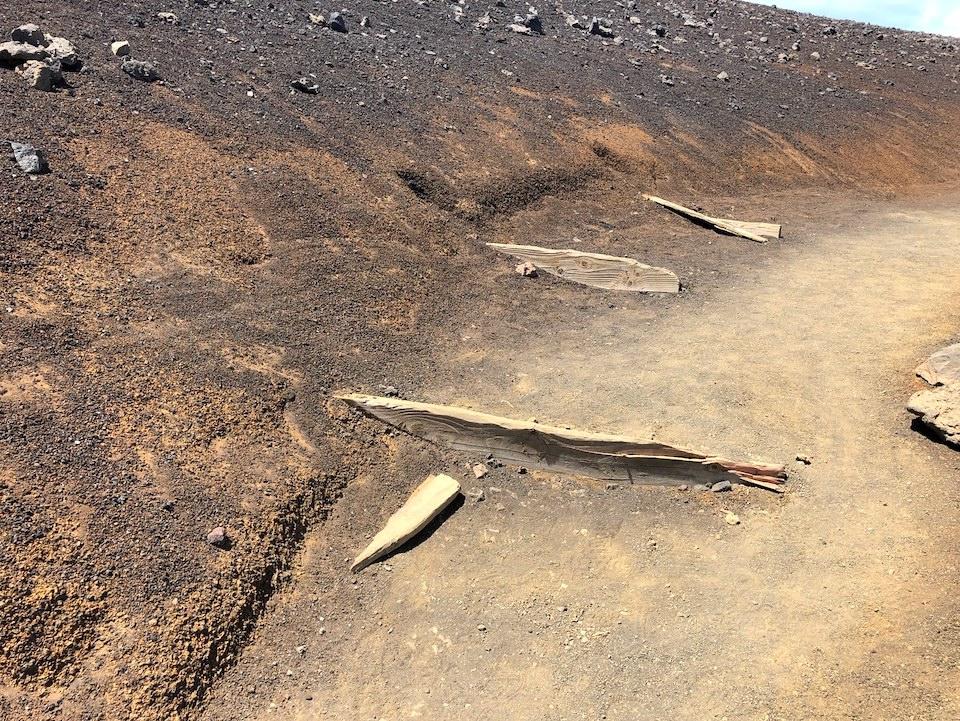
An off-road vehicle killed rare plants near the roof of Haleakala National Park, according to park staff/NPS
A joyriding scofflaw driving off-road near the roof of Haleakalā National Park in Hawai'i killed several threatened Haleakalā silversword plants and damaged a historic trail built by the Civilian Conservation Corps in 1934, according to the National Park Service.
Rangers on Saturday morning discovered vehicle tracks leaving the paved road at Haleakalā’s summit. The investigation revealed that a single vehicle had driven off the road, killing several Haleakalā silverswords, a federally listed threatened plant that grows nowhere else in the world, a park release said Tuesday.
The vehicle also destroyed part of the historic Keonehe’ehe’e trail, built by the CCC in 1934. The National Park Service believes this incident took place late Friday night or very early Saturday morning.

Silversword in partial bloom at Haleakala National Park/NPS
“Those responsible not only killed a federally protected species and damaged a historic resource, but also impacted the scenery at the summit for years to come,” said Chief Ranger Ari Wong. “Those tire tracks in the cinder will take years to disappear."
The National Park Service is asking for the public’s help in identifying those who caused the damage. You can call Haleakalā National Park Law Enforcement at (808) 985-6170, or the National Park Service tip line at (888) 653-0009. Callers can remain anonymous.
The silvery hairs, fleshy leaves, and low-growing rosette form of the Haleakala silversword (Argyroxiphium sandwicense subsp. macrocephalum) allow it to survive in hot, dry climates like the aeolian desert cinder slopes of the crater. Silverswords live between 3 and 90 years or more. They flower once, sending up a spectacular flowering stalk, and then die soon afterward, scattering drying seeds to the wind.
Delicate silverswords ('ahinahina), once ripped up and taken home by visitors as souvenirs, now depend on management efforts for survival. Park staff fence silversword-munching ungulates out, destroy non-native plants that would crowd out silverswords, and educate park visitors to stay on trails to avoid stepping on fragile silversword seedlings and root systems.--NPS

Tracks show where the vehicle left the park road/NPS

The historic Keonehe’ehe’e trail was damaged by the ORV vehicle/NPS



Comments
Mom said, "And that's why we can't have anything nice."
Imagine the spin and outrage if this had taken place during the government shut down......
There was quite a bit of outrage on Traveler's Facebook page, Wild. More than 60 comments and 94 shares. You can't assume a lack of comments on this page sums up all reaction.
I was outraged when I saw the news report; but, at the time, I was entering a temporary phase of being too disgusted to type up anything. Don't worry; I'm rapidly coming out of it. I'll be fine if I can stay away from rightwingers for a while.
"You can't assume a lack of comments on this page sums up all reaction."
I don't, but it is one indicator. So too is a google search that shows a total of 3 local articles on this vandalism compared to pages upon pages proclaiming the impending doom of the national parks because a joshua tree (not listed as endangered) was knocked down during the shut down, along with national news stories and coverage on all the major networks.
Had this vandalism taken place then, instead of the Joshua tree, the same thing would have happened.
It is just another example of blatant media bias and why they have such a credibility problem.
No, wild, it's not another case of "blatant media bias." It's a case of newsworthiness.
Back in January when the incident at Joshua Tree occurred, there was a partial government shutdown and the administration decided to keep the parks open with only a skeleton NPS staff. That was highly newsworthy at the time. So when garbage started piling up, restrooms weren't being cleaned, and vandalism/damage was occuring, it was imminently newsworthy. It was, if you will, the face of the partial shutdown.
Much the same happened in October 2013 during that shutdown. The parks were closed and again became the face of the dispute in Washington.
The incident at Haleakalā occurred when there was no government shutdown and the major news revolved around the impeachment inquiry and the building presidential election and who might be the Democratic nominee.
If we had all jumped in and prompted a lot of coverage of this episode, the wingnuts, probably including wild places, would have raised a stink about "blatant media bias" against offroaders who love "freedom" and "liberty" and want to exercise it on public lands where there shouldn't be all these "oppressive deepstate government" restrictions. You can't please these folks; they never get enough to convince them they're getting their fair share; they're never being celebrated enough or given enough to satisfy them; and it's always somebody else's fault. We're all against them, which is getting to be true; but, not for the reasons they claim.
You are wrong rump. Another straw man that doesn't stand. Us "wingnuts" are law and order types and are just as appalled at ATV's going off road as we are at illegals jumping the boarder. Wild's comments are entirely valid. His point is such vandalism occurs all the time but like so many other things that have been happening forever, it only becomes a newsworthy negative when it happens under the Trump administration.